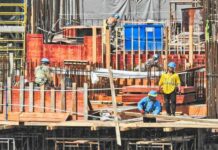Construction is a field that is both rewarding and risky at the same time.
On one hand, construction can provide invaluable experience to those looking to make a living and further their career. Usually, most construction sites are busy hubs of activity with many people working together to focus on one goal, which is to help build America.
Focusing on this goal motivates those who have to work in extremely difficult conditions on a regular basis. While construction is essential to the American public, it’s also one of the riskiest industries to work in, no matter your title or status.
Whether you’re a construction worker, site manager, or just someone passing by, understanding how to stay safe around construction zones is now more important than ever with an increased amount of injuries that happen. But what are some of the best tips on how to stay safe on a construction site? These tips include:
1. Understanding The Hazards
Before you even set foot on a construction site, take time to understand the potential hazards. The most common construction hazards that are usually seen include:
- Falling
- Slipping and Falling
- Hazardous Material Exposure
- Copious Amounts of Noise
- Scaffold-Related Injuries
- Electrical Incidents
- Burn Injuries
- Material Handling
Understanding these risks is the first step to avoiding accidents. It is legally required for your employer to provide training on safety protocols and potential hazards that you can come across on the job.
2. Wearing Appropriate Personal Protective Equipment (PPE)
Wearing the proper personal protective equipment (PPE) on a construction site is crucial to your safety.
So what exactly is PPE?
It is equipment that is worn on the job that is used to prevent or minimize exposure to hazards. The specific PPE you need will depend on your role, but common items include hard hats, safety glasses, ear protection, high-visibility vests, and steel-toed boots. Ensuring your PPE is in good condition and fits well is as crucial as wearing it.
3. Following Safety Protocols and Signs
Every construction site should have clearly marked safety signs and protocols. Signs indicate potential dangers and indicate the need for PPE or specific safety measures.
Always adhere to these guidelines and encourage others to do the same.
4. Keeping Work Areas Clean and Organized
A messy worksite is not just inefficient; it’s also dangerous. Tools, equipment, and materials should be neatly organized and secured when not in use. This helps prevent tripping hazards and reduces the risk of tools falling from heights.
5. Staying Cautious Around Heavy Machinery
Construction sites are full of heavy machinery such as cranes, bulldozers, and excavators. Be aware of your surroundings and avoid walking in blind spots where operators might not see you. Follow hand signals and warnings from machine operators, and never climb or play on equipment.
6. Using Power Tools Safely
Power tools are an essential part of construction, but they can be hazardous if used improperly. Always follow the manufacturer’s instructions and ensure tools are in good working order. When changing blades or bits, disconnect power sources to avoid accidental starts.
7. Avoiding Electrical Hazards
Construction sites often have exposed wiring and temporary electrical systems. Stay clear of these areas, and ensure any electrical work is performed by qualified personnel. Using damaged electrical cords or overloading outlets is a recipe for disaster.
8. Practicing Ladder Safety
Falls are one of the most common construction site accidents. When working on ladders, ensure they are on stable ground, extend at least 3 feet above the landing, and use three points of contact when climbing. Never stand on the top rung of a ladder.
9. Communicating Effectively and Regularly
Good communication is vital to construction site safety. Discuss tasks and expectations with your colleagues, use radios or signals when needed, and report any safety concerns to your supervisor immediately.
10. Staying Informed
Stay updated on the latest safety regulations and best practices in the construction industry. Regular training and education help everyone on the construction site understand and implement safety measures effectively.
By following these tips and respecting construction site safety measures, you can help protect yourself and those around you while contributing to a safer and more productive work environment. Prioritizing safety is not just a legal requirement; it’s a responsibility we all share in the construction industry.
11. Seeking Legal Assistance if Injured
Accidents can happen even when safety precautions are diligently followed. If you find yourself injured on a construction site, it’s important to know your legal rights and options, with the help of an experienced Kent personal injury attorney. Construction injuries can have a significant impact on your life, including medical expenses, lost wages, and potential long-term consequences.
In such cases, it’s often beneficial to seek legal assistance. Here’s how legal support relates to construction injuries:
a. Filing A Workers’ Compensation Claim
In many instances, construction workers are covered by workers’ compensation insurance. This means if you’re injured on the job, you’re entitled to compensation for medical bills, rehabilitation, and a portion of your lost wages. A construction injury attorney can help you navigate the workers’ compensation process, ensuring you receive the benefits you deserve.
b. Determining Third-Party Liability
Construction sites are often a mix of various contractors, subcontractors, and equipment suppliers. If your injury results from the negligence of a third party not directly related to your employer, you may have a third-party liability claim. This type of claim can help you recover additional damages such as pain and suffering, which are not typically covered by workers’ compensation.
In any construction injury case, determining liability is a complex process. Legal professionals can investigate the circumstances of your injury, identify responsible parties, and help you build a strong case. They’ll gather evidence, speak to witnesses, and work to ensure you’re fairly compensated for your injuries.
c. Holding Negligent Parties Accountable
Legal assistance is crucial for holding negligent parties accountable. It sends a message to contractors, employers, and others in the construction industry that safety regulations must be strictly followed. In this way, your case contributes to the overall safety culture of the construction industry.
d. Maximizing Your Potential Compensation
Experienced construction injury attorneys have the knowledge and skills to maximize the compensation you receive. They can assess the true costs of your injuries, including future medical expenses and lost earning potential. By working with an attorney, you can ensure that you’re not left bearing the financial burden of someone else’s negligence.
Remember that legal assistance can be invaluable when it comes to construction injuries. If you’re injured on a construction site, it’s wise to consult with an attorney who specializes in construction injury cases. They can provide guidance, support, and a legal strategy tailored to your specific situation.
Navigating The Journey Ahead
By following these tips and respecting construction site safety measures, you can help protect yourself and those around you while contributing to a safer and more productive work environment. Prioritizing safety is not just a legal requirement; it’s a responsibility we all share in the construction industry.
Construction safety is a collective effort, but legal assistance can help you navigate the complexities of construction injury claims and ensure that your rights are protected when accidents occur. Staying informed, practicing safety measures, and seeking legal counsel when needed are all part of promoting a safer construction industry for everyone involved.




























